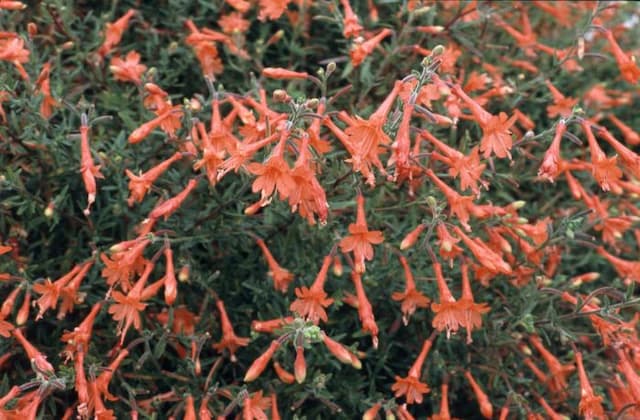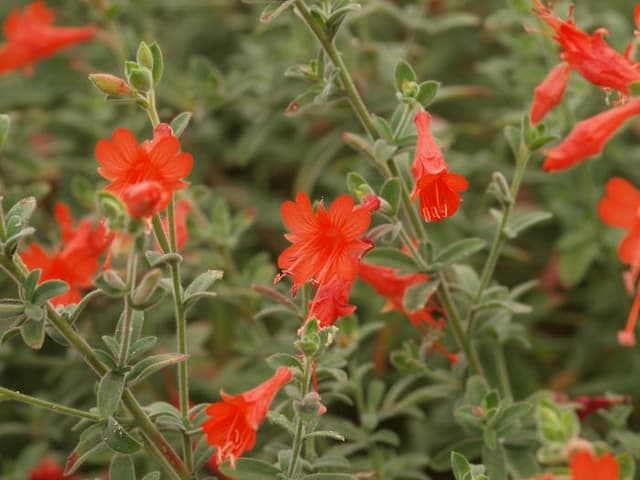Fuchsia Fuchsia 'Flash'

ABOUT
Fuchsia 'Flash' is a captivating plant recognized for its beautiful and distinctive flowers. These blossoms have a two-toned appearance, typically with a deep pink, purple, or red outer layer of petals gracefully surrounding an inner layer of petals, often in a contrasting lighter pink or white color. The flowers dangle elegantly from the plant's branches, resembling delicate lanterns or droplets. The petals are elongated and can sometimes be slightly ruffled, which adds to their whimsical charm. The foliage of Fuchsia 'Flash' complements its flowers, with leaves that are usually dark green in color, creating a lovely background that makes the blooms stand out. The leaves may have a subtle glossy finish and are arranged oppositely along the stems, providing a lush, full appearance to the plant. The stems can sometimes exhibit a slight arch, allowing the flowers to cascade which adds to the ornamental value of the plant. Together, the vibrant flowers and the rich green foliage make Fuchsia 'Flash' a visually stunning addition to any garden or as a potted display, with its colors and forms attracting both admiring glances and pollinators like hummingbirds.
About this plant
 Names
NamesSynonyms
Fuchsia 'Flash', Lady's Eardrops.
Common names
Fuchsia 'Flash'.
 Toxicity
ToxicityTo humans
Fuchsias, including the 'Flash' variety, are generally regarded as non-toxic to humans. They do not contain any known toxic principles that would cause poisoning in humans. Therefore, ingesting parts of the plant typically should not result in any serious symptoms of poisoning. Nevertheless, individual allergies or sensitivities can occur, and it is always advisable to proceed with caution when dealing with any plant material.
To pets
Fuchsias, like the 'Flash' variety, are also typically considered non-toxic to pets, including dogs and cats. They do not contain substances that are known to be harmful to pets, meaning that ingestion of parts of the fuchsia plant is unlikely to cause serious symptoms of poisoning. As with humans, pets can have individual allergies or sensitivities, so it's important to monitor pets and keep a close eye on their interactions with any plants.
 Characteristics
CharacteristicsLife cycle
Perennials
Foliage type
Deciduous
Color of leaves
Green
Flower color
Mixed
Height
1-2 feet (30-60 cm)
Spread
1-2 feet (30-60 cm)
Plant type
Shrub
Hardiness zones
9
Native area
Central and South America
Benefits
 General Benefits
General Benefits- Attractive Flowers: Fuchsia 'Flash' has striking, pendulous flowers that add a splash of color to any garden.
- Hummingbird Magnet: Its vibrant blooms are known to attract hummingbirds, providing natural pollination.
- Shade Tolerant: This plant can thrive in part shade, making it suitable for various garden spots that don't get full sun.
- Extended Blooming Period: Fuchsia 'Flash' has a lengthy flowering season, offering visual interest throughout the spring and summer months.
- Container Gardening: It's well-suited for pots and hanging baskets, allowing for versatile garden design and balcony decoration.
- Easy Propagation: It can be readily propagated from cuttings, making it easy to share with fellow gardeners or expand your own collection.
 Medical Properties
Medical PropertiesThis plant is not used for medical purposes.
 Air-purifying Qualities
Air-purifying QualitiesThis plant is not specifically known for air purifying qualities.
 Other Uses
Other Uses- Dye Production: The fuchsia flowers and berries can be used to create a natural dye for fabrics, offering a range of pink to purple hues depending on the mordant used.
- Ink Making: By crushing the berries of the fuchsia plant, one can produce a homemade ink for use in arts and crafts, providing unique, natural colors.
- Fairy Gardens: Fuchsia 'Flash' can be incorporated into fairy gardens due to its delicate and fairy-like appearance, adding a touch of whimsy and vibrant color.
- Culinary Garnish: The vibrant flowers of the fuchsia plant can be used as an edible garnish to brighten up salads and desserts with their striking color and subtly sweet flavor.
- Photography Prop: Fuchsia plants serve as excellent photography subjects or props due to their vivid coloration and intricate flower shape, providing a beautiful backdrop or focal point.
- Watercolor Pigment: The juice from fuchsia berries can be used as a pigment for watercolor painting, giving artists access to natural, plant-based colors for their artwork.
- Plant Sculpture: With proper training and pruning, fuchsia 'Flash' can be grown into various shapes and forms, making it suitable for topiary or plant sculpture.
- Educational Resource: Fuchsias can be used in educational settings to teach students about plant biology, pollination, and the care of living organisms.
- Bird Attractant: The plant can serve as a natural attractant in gardens for certain bird species, such as hummingbirds, which enjoy the nectar from its flowers.
- Floral Crafts: The blossoms and leaves of fuchsia can be used in floral crafts, including making wreaths, hair accessories, or pressed flower arrangements.
Interesting Facts
 Feng Shui
Feng ShuiThe Fuchsia is not used in Feng Shui practice.
 Zodiac Sign Compitability
Zodiac Sign CompitabilityThe Fuchsia is not used in astrology practice.
 Plant Symbolism
Plant Symbolism- Confidence: The vibrant and striking colors of the Fuchsia flower are often associated with confidence, as they stand out boldly in a garden setting.
- Elegance: Fuchsia plants have a graceful drooping habit and delicate, teardrop-shaped flowers, which convey a sense of elegance and finesse.
- Good Taste: The Fuchsia flower is known for its unique and ornate appearance, symbolizing a person's good taste and appreciation for beauty.
- Vivid Imagination: The unusual shape and combination of colors in the Fuchsia can represent a creative and vivid imagination, inspiring gardeners and onlookers.
- Overflowing Abundance: Fuchsia plants are prolific bloomers, symbolizing abundance and generosity.
 Water
WaterFuchsias, commonly known as Lady's Eardrops, require consistent moisture and should not be allowed to dry out, especially during the growing season. Water them thoroughly when the top inch of soil feels dry to the touch. Aim to use about 1 gallon of water per plant for a typical outdoor potted Fuchsia every week during the summer, but adjust based on heat and wind conditions. Less water will be needed during the winter when the plant is not in active growth. Ensure the pot has good drainage to avoid waterlogging, which can cause root rot.
 Light
LightLady's Eardrops thrive in bright, indirect light with protection from the afternoon sun. The ideal spot for these plants is where they receive morning sunlight and shaded relief from the more intense afternoon rays. An eastern-facing patio or a spot under a lightly shaded tree would provide optimal light conditions for healthy growth without the risk of scorching their delicate leaves.
 Temperature
TemperatureLady's Eardrops prefer a cooler climate and do best in temperatures ranging between 55°F and 75°F. They can survive temporarily outside this range but should not be exposed to temperatures below 40°F or above 80°F for extended periods. The cooler temperatures within their preferred range encourage prolonged blooming and healthier foliage.
 Pruning
PruningPruning Lady's Eardrops helps maintain their shape, encourages bushier growth, and promotes more abundant flowering. Pinch or cut back the tips of the branches after flowering to stimulate new growth. The best time for major pruning is in late winter or early spring before new growth begins, but light pruning can be done throughout the growing season as needed.
 Cleaning
CleaningAs needed
 Soil
SoilThe best soil mix for Fuchsia 'Flash', commonly known as Fuchsia, should be well-draining and fertile, with a pH between 6.0 and 7.0. A mixture of loam, peat, and sand in equal parts is ideal, ensuring proper drainage and aeration.
 Repotting
RepottingFuchsias, including the Fuchsia 'Flash', should be repotted every two to three years. Younger plants may require annual repotting if they are growing vigorously and becoming root-bound.
 Humidity & Misting
Humidity & MistingFuchsia 'Flash' thrives best in high humidity conditions; aiming for a humidity level between 60% to 70% is ideal for these plants.
 Suitable locations
Suitable locationsIndoor
Provide bright, indirect light and maintain high humidity for indoor Fuchsia 'Flash'.
Outdoor
Keep Fuchsia 'Flash' in partial shade and sheltered from strong winds when grown outside.
Hardiness zone
10-11 USDA
 Life cycle
Life cycleFuchsia 'Flash', commonly known as Hardy Fuchsia, begins its life cycle when the seeds are sown in fertile, well-draining soil, usually in late winter or early spring. After germination, the seedlings grow into young plants with characteristic dark-green, oval leaves. As temperatures increase in spring, robust vegetative growth occurs and the plants are often pinched back to encourage bushiness. Flower buds develop later in spring, leading to the blooming period in summer where the signature pendulous, teardrop-shaped flowers in vibrant shades of pink and purple attract pollinators. Following pollination, the flowers give way to small fruit containing seeds, completing the reproductive cycle. The plant will then enter a period of dormancy during the cold winter months, especially in cooler climates.
 Propogation
PropogationPropogation time
Spring-Early Summer
Fuchsia 'Flash', commonly known as Fuchsia, is often propagated through stem cuttings, which can be done in late spring to early summer. To propagate using this method, a gardener takes a cutting of about 2-4 inches (5-10 cm) from a healthy, non-flowering shoot. The lower leaves of the cutting are removed, and the stem is dipped in rooting hormone to encourage root growth. The cutting is then placed in a pot filled with moist, well-draining soil or a mix of peat and perlite, ensuring that the leaf nodes, where new roots are likely to form, are submerged in the medium. The pot is then covered with a plastic bag or placed in a propagator to maintain high humidity around the cutting. Roots typically develop within 3-4 weeks, after which the new Fuchsia plant can be gradually acclimatized to normal growing conditions.









